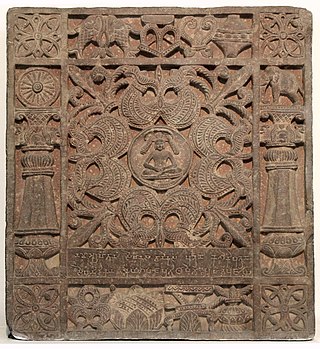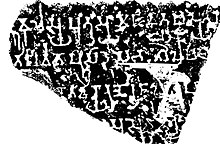
Rajuvula was an Indo-Scythian Great Satrap (Mahākṣatrapa), one of the "Northern Satraps" who ruled in the area of Mathura in the northern Indian Subcontinent in the years around 10 CE. The Mathura lion capital was consecrated under the reign of Rajuvula. In central India, the Indo-Scythians had conquered the area of Mathura from Indian kings around 60 BCE. Some of their satraps were Hagamasha and Hagana, who were in turn followed by Rajuvula.

Sodasa was an Indo-Scythian Northern Satrap and ruler of Mathura during the later part of the 1st century BCE or the early part of 1st century CE. He was the son of Rajuvula, the Great Satrap of the region from Taxila to Mathura. He is mentioned in the Mathura lion capital.
Saunkh, often spelled as Sonkh, is a town and a Nagar Panchayat in Mathura district of Uttar Pradesh, India.

Indo-Greek art is the art of the Indo-Greeks, who reigned from circa 200 BCE in areas of Bactria and the Indian subcontinent. Initially, between 200 and 145 BCE, they remained in control of Bactria while occupying areas of Indian subcontinent, until Bactria was lost to invading nomads. After 145 BCE, Indo-Greek kings ruled exclusively in parts of ancient India, especially in Gandhara, in what is now present-day the northwestern Pakistan. The Indo-Greeks had a rich Hellenistic heritage and artistic proficiency as seen with the remains of the city of Ai-Khanoum, which was founded as a Greco-Bactrian city. In modern-day Pakistan, several Indo-Greeks cities are known such as Sirkap near Taxila, Barikot, and Sagala where some Indo-Greek artistic remains have been found, such as stone palettes. Some Buddhist cultural objects related to the Indo-Greeks are known, such as the Shinkot casket.By far the most important Indo-Greek remains found are numerous coins of the Indo-Greek kings, considered as some of the most artistically brilliant of Antiquity. Most of the works of art of the Greco-Buddhist art of Gandhara are usually attributed to the direct successors of the Indo-Greeks in Ancient India in the 1st century CE, such as the nomadic Indo-Scythians, the Indo-Parthians and, in an already decadent state, the Kushans. Many Gandharan works of art cannot be dated exactly, leaving the exact chronology open to interpretation. With the realization that the Indo-Greeks ruled in India until at least 10-20 CE with the reign of Strato II in the Punjab, the possibility of a direct connection between the Indo-Greeks and Greco-Buddhist art has been reaffirmed recently.

Vāsudeva, later incorporated as Vāsudeva-Krishna, Krishna-Vāsudeva or simply Krishna, was the son of Vasudeva Anakadundubhi, king of the Vrishnis in the region of Mathura. He was a leading member of the Vrishni heroes, and may well have been an historical ruler in the region of Mathura.

Ayagapata (Hindi:अयागपट्ट) or Ayagapatta is a type of votive slab associated with worship in Jainism.
The Northern Satraps, or sometimes Satraps of Mathura, or Northern Sakas, are a dynasty of Indo-Scythian rulers who held sway over the area of Eastern Punjab and Mathura after the decline of the Indo-Greeks, from the end of the 1st century BCE to the 2nd century CE. They are called "Northern Satraps" in modern historiography to differentiate them from the "Western Satraps", who ruled in Gujarat and Malwa at roughly the same time and until the 4th century CE. They are thought to have replaced the last of the Indo-Greek kings in the Eastern Punjab, as well as the Mitra dynasty and the Datta dynasty of local Indian rulers in Mathura.

The Mitra dynasty refers to a group of local rulers whose name incorporated the suffix "-mitra" and who are thought to have ruled in the area of Mathura from around 150 BCE to 50 BCE, at the time of Indo-Greek hegemony over the region, and possibly in a tributary relationship with them. They are not known to have been satraps nor kings, and their coins only bear their name without any title, therefore they are sometimes simply called "the Mitra rulers of Mathura". Alternatively, they have been dated from 100 BCE to 20 BCE. The Mitra dynasty was replaced by the Indo-Scythian Northern Satraps from around 60 BCE.
The Yavanarajya inscription, also called the Maghera Well Stone Inscription, was discovered in the village of Maghera, 17 kilometers north of Mathura, India in 1988. The Sanskrit inscription, carved on a block of red sandstone, is dated to the 1st century BCE, and is currently located at the Mathura Museum in Mathura. The inscription notes the donation of a water well and tank to the community in 1st century BCE, built by a Brahmana.

The Art of Mathura refers to a particular school of Indian art, almost entirely surviving in the form of sculpture, starting in the 2nd century BCE, which centered on the city of Mathura, in central northern India, during a period in which Buddhism, Jainism together with Hinduism flourished in India. Mathura "was the first artistic center to produce devotional icons for all the three faiths", and the pre-eminent center of religious artistic expression in India at least until the Gupta period, and was influential throughout the sub-continent.

The Datta dynasty is a dynasty of ruler who flourished in the northern India in the areas of Mathura and Ayodhya around the 1st century BCE – 1st century CE. They are named after the "-datta" ending of their name, and essentially only known through they coins. It is thought that they replaced the Deva dynasty, which had originated with the rise of Sunga Empire Pushyamitra, and that they were in turn replaced by the Mitra dynasty.

The Mora Well inscription is an ancient Sanskrit inscription found in the village of Mora about 7 miles (11 km) from Mathura, India. It is notable for its early mention of pratima (images), stone temple, and the Pancaviras.

The Vasu Doorjamb Inscription is an early 1st-century CE Sanskrit inscription in Brahmi script dedicated to the deity Vāsudeva, related to the Vaishnavism tradition of Hinduism. It is also one of the several dedicatory inscriptions from Mathura bearing the name of the Indo-Scythian Northern Satrap ruler Sodasa, which are useful as historic markers for the first half of the 1st century CE.

Dhanabhūti or Vatsiputra Dhanabhūti was a 2nd or 1st-century BCE Buddhist king in Central India, and the most prominent donor for the Bharhut stupa. He appears in two or three major dedicatory inscriptions at the stupa of Bharhut, and possibly in another inscription at Mathura. Dhanabhuti may have been a feudatory of the Sunga Empire, or a ruler in a neighbouring territory, such as Kosala or Panchala, or possibly a northern king from Sughana in Punjab. He may have also been part of the Mitra dynasty of Kosambi.

Mudgarpani was a Yaksha deity in ancient India. His name means "Mudgar-holder", the Mudgar being an ancient form of heavy club, usually made of wood, but it can also be made of iron.

The Mirzapur stele inscription, also called the Mirjāpur stele inscription, is a dedicatory inscription on a large stone slab discovered in the Mirzapur area of Mathura which mentions the erection of a water tank by Mulavasu and his consort Kausiki, during the reign of the Sodasa, the Indo-Scythian Northern Satrap ruler of Mathura, assuming the title of "Svami (Lord) Mahakshatrapa ".

The Vrishni heroes, also referred to as Pancha-viras, are a group of five legendary, deified heroes who are found in the literature and archaeological sites of ancient India. Their earliest worship is attestable in the clan of the Vrishnis near Mathura by 4th-century BCE. Legends are associated with these deified heroes, some of which may be based on real, historical heroes of the Vrishni clan. Their early worship has been variously described as cross-sectarian, much like the cult of the Yakshas, related to the early Bhagavata tradition of Hinduism, and with possible links to Jainism as well. They and their legends – particularly of Krishna and Balarama – have been an important part of the Vaishnava tradition of Hinduism.

The Jain stupa was a type of stupa erected by the Jains for devotional purposes. A Jain stupa dated to the 1st century BCE-1st century CE was excavated at Mathura in the 19th century, in the Kankali Tila mound.

Indo-Scythian art developed under the various dynasties of Indo-Scythian rulers in northwestern India, from the 1st century BCE to the early 5th century CE, encompassing the productions of the early Indo-Scythians, the Northern Satraps and the Western Satraps. It follows the development of Indo-Greek art in northwestern India. The Scythians in India were ultimately replaced by the Kushan Empire and the Gupta Empire, whose art form appear in Kushan art and Gupta art.

The Pārśvanātha āyāgapaṭa, is a large stone slab discovered in Kankali which has an image of Parshvanatha, dating back to reign Sodasa, of Indo-Scythian Northern Satrap, the ruler Sodasa in Mathura. The tablet in the State Museum Lucknow. It is an important example of Mathura art.



















